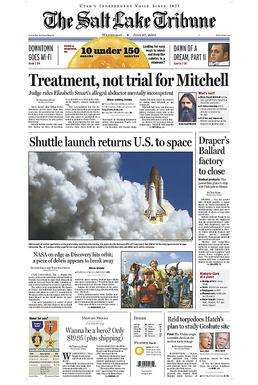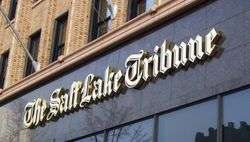The Salt Lake Tribune
The Salt Lake Tribune is a daily newspaper published in the city of Salt Lake City, Utah, with the largest paid circulation in the state. The Tribune is owned by The Salt Lake Tribune, Inc., a non-profit corporation. For almost 100 years, it was a family-owned newspaper held by the heirs of U.S. Senator Thomas Kearns. After Kearns died in 1918, the company was controlled by his widow, Jennie Judge Kearns, and then the newspaper's longtime publisher was John F. Fitzpatrick, who started his career as secretary to Senator Kearns in 1913 and remained publisher until his death in 1960. John W. Gallivan, nephew of Mrs. Kearns, joined the Tribune in 1937 and succeeded Fitzpatrick as publisher in 1960, remaining as Chairman until the merger with TCI, Inc. in 1997.
 The July 27, 2005, front page of The Salt Lake Tribune | |
| Type | Daily newspaper |
|---|---|
| Format | Broadsheet |
| Owner(s) | The Salt Lake Tribune, Inc. (a non-profit corporation) |
| President | Paul Huntsman |
| Editor | David Noyce (interim editor) |
| Founded | 1870 (as the Mormon Tribune) |
| Headquarters | 90 South 400 West Suite 700 Salt Lake City, Utah 84101 USA |
| Circulation | 74,043 84,137 Sunday (2015 paid distribution)[1] |
| ISSN | 0746-3502 |
| Website | www |
On April 20, 2016, Huntsman Family Investments, a private equity firm headed by Paul Huntsman, son of industrialist Jon Huntsman, Sr., announced that it would be buying the Tribune.[2] He soon announced plans to take the paper non-profit. In November 2019 the newspaper won approval from the Internal Revenue Service to become a 501(c)(3) non-profit.[3]
The newspaper's motto, at the top of its masthead, is "Utah's Independent Voice Since 1871".
History
A successor to Utah Magazine (1868),[4][5] as the Mormon Tribune by a group of businessmen led by former members of The Church of Jesus Christ of Latter-day Saints (LDS Church) William Godbe, Elias L.T. Harrison and Edward Tullidge, who disagreed with the church's economic and political positions. After a year, the publishers changed the name to the Salt Lake Daily Tribune and Utah Mining Gazette, but soon after that, they shortened it to The Salt Lake Tribune.
Three Kansas businessmen, Frederic Lockley, George F. Prescott and A.M. Hamilton, purchased the company in 1873 and turned it into an anti-Mormon newspaper which consistently backed the local Liberal Party. Sometimes vitriolic, the Tribune held particular antipathy for LDS Church president Brigham Young. In the edition announcing Young's death, the Tribune wrote,
- He was illiterate and he has made frequent boast that he never saw the inside of a school house. His habit of mind was singularly illogical and his public addresses the greatest farrago of nonsense that ever was put in print. He prided himself on being a great financer, and yet all of his commercial speculations have been conspicuous failures. He was hierophant, and pretended to be in daily [communion] with the Almighty, and yet he was groveling in his ideas, and the system of religion he formulated was well nigh Satanic. — The Salt Lake Tribune, August 30, 1877[6]
In 1901, newly elected United States Senator Thomas Kearns, a Roman Catholic, and his business partner, David Keith, secretly bought the Tribune. Kearns made strides to eliminate the paper's anti-Mormon overtones, and succeeded in maintaining good relationships with the mostly-LDS state legislature which had elected him to the Senate. After Keith died in 1918 the Kearns family bought out Keith's share of the Salt Lake Tribune Publishing Company. Eventually, the parent company became Kearns-Tribune Corporation.
The company started up an evening edition in 1902, known as The Salt Lake Telegram. The Telegram was sold in 1914 and reacquired by the Tribune in 1930. It was phased out when the joint operating agreement was formed with the afternoon Deseret News, Salt Lake's daily newspaper owned by the LDS Church, in 1952.[7]

John F. Fitzpatrick became publisher in 1924, ushering in what became seven decades of peaceful coexistence with the dominant LDS Church. In 1952 theTribune entered into a joint operating agreement with the Deseret News and created the Newspaper Agency Corporation.[8] Fitzpatrick was the architect of NAC at the request of LDS Church President David O. McKay whose newspaper was near bankruptcy at the time. Fitzpatrick died of a heart attack in 1960, and was succeeded by John W. Gallivan, who had been trained as the next publisher from the time he joined the Tribune in 1937. Gallivan often joked with aspiring journalism students, telling them the best way to the publisher's desk was to get yourself left on the doorstep of the owner. (He had been orphaned at the age of five, then taken in by his mother's half-sister, Mrs. Thomas Kearns.) In the late 1950s, in spite of reluctance from John Fitzpatrick about the future of television, Gallivan joined a measured Tribune investment with The Standard Corporation in Ogden, Utah, to build one of the first microwave and cable TV systems across northern Nevada. On weekends, Gallivan traveled by bus to Elko, Nevada, to oversee the construction beginnings. Gallivan and Denver cable investor Bob Magness merged their companies into Tele-Communications Inc. (TCI) which eventually became the largest cable television company in the world. The Tribune's ownership interest in TCI reached nearly 15%, which played a large role in later mergers between the two companies. Gallivan remained as Tribune publisher until 1984, and chairman of the board until 1997.[9]
The Kearns family owned a majority share of the newspaper until 1997, when the company merged with TCI in an effort to minimize inheritance tax liabilities borne by the two largest shareholders in the Kearns family. A buy-back agreement was put in place, providing for the Kearns family to reacquire The Tribune, after the IRS required a five-year holding period. However, in the interim TCI was merged with AT&T Corporation. After intense pressure from the LDS Church, and intense counter-suits from the Kearns family, the Tribune was subsequently sold by AT&T to Denver, Colorado-based MediaNews Group in 2000.[10]
In 2002, the Tribune was mired in controversy after employees sold information related to the Elizabeth Smart kidnapping case to The National Enquirer. Tribune editor James "Jay" Shelledy resigned from his job at the paper amid the fallout of the scandal. Two staffers also were removed from their positions as Tribune reporters.
In 2004 the paper decided to move from its historic location at the downtown Tribune building, to The Gateway development. Many people, including several Tribune employees, opposed the move, stating that it would harm the economy of Salt Lake's downtown. The move was completed in May 2005 and Tribune employees were told by Editor Nancy Conway, "It is just a building."
After emerging from bankruptcy in 2010, MediaNews Group lost control of its ownership to a hedge fund, Alden Global Capital. "The remainder of the Denver-based chain is owned by a consortium of lenders and by Singleton himself."[11] In 2016, Huntsman Family Investments, LLC, a company controlled by Paul Huntsman, bought The Salt Lake Tribune.[12] Paul Huntsman is the son of industrialist Jon Huntsman, Sr. who serves as chairman of the holding company, and brother of former Utah governor and ambassador to Russia Jon Huntsman, Jr..[13]
In 2012, as it had in 2008,[14] The Salt Lake Tribune endorsed Barack Obama for the presidency, despite opponent Mitt Romney's connections with both Mormonism and Salt Lake City, having had a hand in organizing the city's 2002 Olympic Games.[15]
In 2017, the Tribune was awarded the Pulitzer Prize for Local Reporting for "a string of vivid reports revealing the perverse, punitive and cruel treatment given to sexual assault victims at Brigham Young University, one of Utah’s most powerful institutions."[16] The team included lead reporter Erin Alberty, managing editor Sheila R. McCann, reporters Jessica Miller and Alex Stuckey and editor/writer Rachel Piper. The package of winning stories also included an investigation into multiple reports that were not properly investigated by Utah State University.[17]
In a December 2017 editorial, the Tribune called for Utah Senator Orrin Hatch to retire in 2018.[18]
In May 2018, the Tribune laid off over one third of its staff of 90, bringing the number to 56. The reason put forward for this was lower revenue due to decreased circulation and lower profit from online advertisements. This was despite a paywall having been placed months earlier on the Tribune website.[19]
In November 2019, the newspaper won approval from the Internal Revenue Service to become a 501(c)(3) non-profit.[3]
See also
- Harold Schindler – historian, television screenwriter and editor for The Salt Lake Tribune
- Peggy Fletcher Stack – religion reporter for The Salt Lake Tribune
- Robert Kirby – humor columnist for The Salt Lake Tribune
- Florabel Muir - first female reporter for The Salt Lake Tribune
- Frank Hewlett - Washington bureau chief
References
- "US Postal Service Statement of Ownership, Management and Circulation (form 3526)". The Salt Lake Tribune. Salt Lake City. October 6, 2015. p. A6.
- Semerad, Tony (April 20, 2016). "Huntsman family buying The Salt Lake Tribune, hopes to ensure 'independent voice for future generations'". The Salt Lake Tribune. Retrieved April 20, 2016.
- "Salt Lake Tribune gets IRS approval to convert to nonprofit". Associate Press. Retrieved 2019-11-04.
- Leaders of the LDS Church had urged its members to eschew the Utah Magazine; its owners formed the Mormon Tribune in 1870 in retaliation.
- Bennion, Sherilyn Cox (1994), "Salt Lake Tribune", in Powell, Allan Kent (ed.), Utah History Encyclopedia, Salt Lake City, Utah: University of Utah Press, ISBN 0874804256, OCLC 30473917, archived from the original on 2013-11-01
- "Brigham Young As A Ruler". The Salt Lake Daily Tribune. August 30, 1877. p. 2. Retrieved 12 January 2018.
- Malmquist,The First 100 Years, pp. 323–324.
- Malmquist, The First 100 Years, p.?
- Malmquist,The First 100 Years, pp. 373–376.
- Barringer, Felicity (16 December 2000). "MediaNews Allowed to Buy Utah Paper from AT&T". The New York Times. Retrieved December 10, 2012.
- Beebe, Paul (January 29, 2011). The Salt Lake Tribune.
- Semerad, Tony (April 21, 2016). "Huntsman family buying The Salt Lake Tribune, hopes to ensure 'independent voice for future generations'". The Salt Lake Tribune.
- Rosman, Katherine (2019-05-17). "Can Paul Huntsman Save The Salt Lake Tribune?". The New York Times. ISSN 0362-4331. Retrieved 2019-11-04.
- Mooney, Brian C. (October 19, 2012). "Salt Lake Tribune endorses President Obama over Mitt Romney, who organized city's Olympics". The Boston Globe. Retrieved October 30, 2013.
- "Tribune endorsement: Too Many Mitts". The Salt Lake Tribune. November 5, 2012. Retrieved October 30, 2013.
- "Salt Lake Tribune wins Pulitzer for campus rape coverage, praises victims for sharing their stories". Salt Lake Tribune. April 17, 2017. Retrieved September 28, 2018.
Tribune wins Pulitzer
- "The Salt Lake Tribune Staff - The Pulitzer Prizes". April 17, 2017.
Local reporting - The Pulitzer Prizes
- "Tribune Editorial: Why Orrin Hatch is Utahn of the Year". Salt Lake Tribune. December 25, 2017. Retrieved December 26, 2017.
It would be good for Utah if Hatch, having finally caught the Great White Whale of tax reform, were to call it a career. If he doesn’t, the voters should end it for him.
- "The Salt Lake Tribune Lays Off One-Third of Newsroom Staff". The New York Times. 2018-05-14. ISSN 0362-4331. Retrieved 2018-05-17.
Sources
- Malmquist, Orvin Nebeker (1971), The First 100 Years, A History of the Salt Lake Tribune 1871-1971, Salt Lake City, UT: Utah State Historical Society, OCLC 161035
Further reading
- "2007 Top 100 Daily Newspapers in the U.S. by Circulation" (PDF), BurrellesLuce.com, Burrelles Luce, 2007-03-31, retrieved 2013-02-13
- Bennion, Sherilyn Cox (1994), "The Salt Lake Tribune", in Powell, Allan Kent (ed.), Utah History Encyclopedia, Salt Lake City, UT: University of Utah Press, p. 288, ISBN 0874804256, OCLC 30473917, archived from the original on 2013-11-01